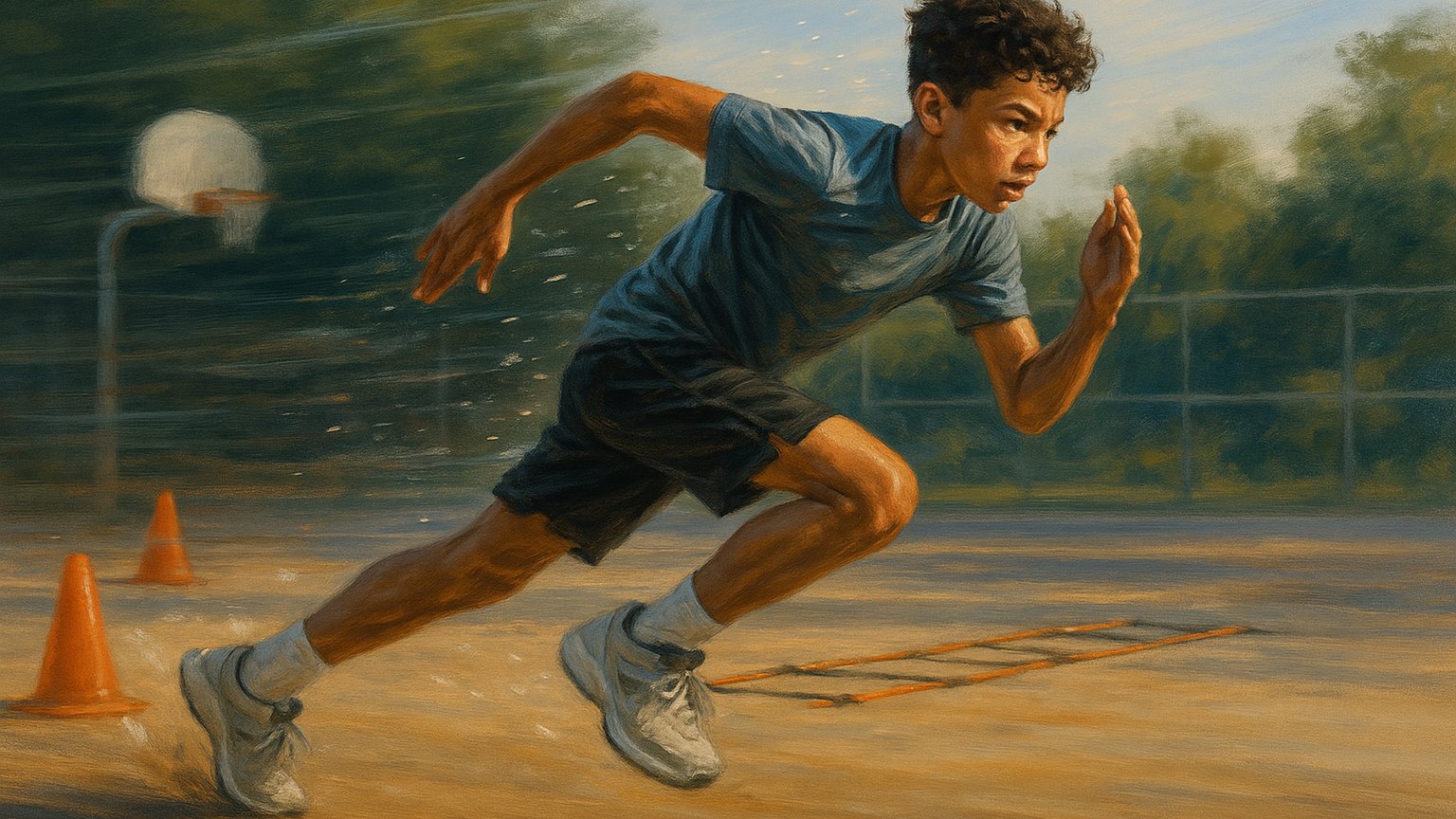Every young basketball player dreams of breaking away from defenders with explosive first steps, racing down the court with unstoppable energy, and moving so fast it feels like time slows down. But not every player starts out quick. Some feel sluggish during fast breaks, hesitate when rotating on defense, or get beat in one-on-one matchups simply because their footwork and acceleration haven’t caught up with their skill. The truth is, speed isn’t just a natural gift—it’s a trainable skill. And the journey from slow to lightning fast is one that any young baller can begin, with the right guidance, the right training, and the right mindset.
Speed is often misunderstood. In youth basketball, it’s not just about straight-line sprinting. It’s about quickness, reaction time, body control, and the ability to explode in any direction. The player who masters these elements becomes a force on both ends of the floor, capable of creating space, disrupting plays, and shifting the momentum of a game with just a burst of movement. Whether you’re a young athlete looking to get faster or a coach or parent ready to guide them, the path to speed is not only possible—it’s exciting, empowering, and transformative.
Let’s dive into what it really takes to turn a slow-moving player into a lightning-fast game changer.
Redefining Speed in the Game of Basketball
When we talk about speed in basketball, we’re not talking about Olympic sprinter speed. We’re talking about court-specific quickness. Speed in basketball is about how fast a player can accelerate off the dribble, how quickly they can change direction, how effectively they can recover on defense, and how well they move without the ball. It’s an integrated skill that blends reaction time, agility, coordination, strength, and spatial awareness.
For young athletes, this kind of speed develops over time—not overnight. It begins with learning how to move efficiently. Many youth players have never been taught how to sprint, stop, or cut correctly. They run with choppy steps, their arms flail, their knees barely lift, and they often tire quickly. These movement inefficiencies are not permanent flaws. They are simply signs that there’s massive room for improvement.
The first step in building speed is understanding that it’s not about being born fast. It’s about becoming fast by training smart, moving well, and practicing consistently. And when that mindset takes root, transformation begins.
Building the Foundation: Posture, Form, and Mechanics
All great speed begins with great movement mechanics. Before a young baller can become explosively fast, they need to learn how to move their body with precision and control. This starts with posture—tall spine, relaxed shoulders, and a strong, engaged core. Whether sprinting in transition or sliding defensively, posture anchors the body and allows energy to transfer efficiently from the ground up.
Running form is another crucial piece. Many young players run without utilizing their arms effectively. Proper arm drive—bent elbows pumping cheek to hip—can dramatically improve rhythm and speed. Feet should strike the ground under the hips, not in front, with strong knee drive and quick turnover.
One of the most overlooked elements is the start. The first few steps of a sprint are where acceleration is built. Teaching young players how to push off with force, drive the knees, and stay low during take-off can give them a noticeable advantage. These habits take time, but with repetition, they become automatic—and powerful.
Drilling for Acceleration: Short Bursts with Purpose
Acceleration is the ability to go from standing still to top speed in just a few strides. In basketball, it’s the most valuable form of speed. Most plays happen in short bursts—sprinting for a layup, chasing a rebound, or closing out on a shooter. That means speed training should mimic this reality.
Short sprints of 10 to 20 yards, performed with maximum effort and full recovery between reps, help train the body to fire quickly. Emphasizing proper starts—whether from a staggered stance, lateral position, or triple-threat pose—helps transfer that training directly to game situations.
To increase explosiveness, plyometric exercises such as squat jumps, bounding, and box jumps can be added. These drills teach the muscles to react and contract faster, which translates to quicker steps and more dynamic movement on the court.
Young athletes should be coached to focus on quality, not just quantity. The goal is to run fast, rest fully, and repeat with precision. Over time, the acceleration gained from this approach shows up in every game.
The Magic of Multi-Directional Speed
Basketball is a game of constant change—stop and go, side to side, forward and backward. The best players aren’t just fast in a straight line—they’re fast in every direction. That’s why multi-directional speed is the next crucial layer.
Lateral movement drills such as cone shuffles, defensive slides, and zigzag patterns help athletes develop agility while staying low and balanced. These drills strengthen the hips, glutes, and core—all of which are essential for cutting quickly and holding defensive positions.
Change-of-direction speed training involves teaching players how to decelerate under control, plant with power, and explode in a new direction. Think of a crossover dribble, a spin move, or a sudden cut to get open—these are all dependent on elite deceleration and redirection.
To enhance this ability, incorporate drills that force reaction: tag-style games, mirror drills, and reaction-based sprints where a partner or coach gives visual or audio cues. These exercises make footwork smarter and faster, which can be a game-changer for players who struggle to stay with quicker opponents.
Strength Training for Speed and Stability
Speed isn’t just about fast feet. It’s about strength—particularly in the legs, hips, and core. A stronger body can push off the ground harder, maintain better posture while sprinting, and absorb impact when stopping or changing direction.
For young athletes, strength training doesn’t need to mean heavy weights. Bodyweight exercises like squats, lunges, push-ups, and planks provide an excellent foundation. Resistance bands, medicine balls, and light dumbbells can be added over time to introduce new challenges and progressions.
Jump training also plays a major role. Exercises like tuck jumps, lateral bounds, and depth jumps not only build lower-body power but also improve landing mechanics, which are critical for both injury prevention and explosive movement.
A strong core is equally essential. It connects the upper and lower body, stabilizes every movement, and ensures that energy isn’t wasted through wobble or poor control. Core workouts should include rotation, anti-rotation, and balance-based challenges to build a resilient and reactive athlete.
Consistency and Recovery: The Secret Ingredients
Training for speed takes time. Young athletes often want to see immediate results, but the real gains come from consistent, focused effort repeated over weeks and months. That’s why it’s so important to create a schedule that’s sustainable, not overwhelming.
Two or three dedicated speed sessions per week, along with regular team practices and games, is usually plenty. Each session should be no longer than 30 to 45 minutes and should include a proper warm-up, movement drills, and recovery.
Rest is just as important as training. Without adequate sleep, hydration, and downtime, the body can’t adapt. Growth happens between sessions, not during them. Encourage young players to listen to their bodies, take rest days seriously, and stay fueled with nutritious food.
Celebrate small improvements—shaving a tenth of a second off a sprint, performing drills with sharper form, or reacting quicker in a game. These are signs that the work is paying off.
Building the Mindset of a Fast Player
Speed isn’t only physical—it’s mental. Fast players anticipate, react, and commit without hesitation. Helping young athletes develop a speed-focused mindset means teaching them to trust their instincts, believe in their training, and attack every drill with intent.
Visualizing plays, watching film, and mentally rehearsing game scenarios can accelerate this mental speed. So can playing fast-paced games, engaging in one-on-one challenges, and learning to push past the discomfort of fatigue during workouts.
Encouragement from parents and coaches plays a huge role. Young players who hear “you’re getting faster,” or “that move was lightning quick” begin to identify as fast. And when that belief sets in, it drives even greater performance.
The confidence that comes from feeling fast on the court is transformative. It affects everything—decision-making, assertiveness, and joy in the game.
Making Speed Training Fun and Engaging
Let’s be honest—kids don’t want to feel like they’re in boot camp. To keep young athletes motivated, speed training has to be fun. That means integrating play into every session. Use competitive drills, relay races, partner challenges, and reaction games. Keep things fresh and exciting.
Music, mini-games, rewards, and variety go a long way. One week could feature basketball obstacle courses; the next could focus on sprint relays and team challenges. The more a young athlete enjoys the process, the more likely they are to stick with it—and the more progress they’ll make.
When players look forward to training, they give more effort. When they give more effort, they improve faster. When they improve faster, they believe in themselves. And that belief is what turns slow players into fast ones—on and off the court.
Transforming Confidence Through Speed
The journey from slow to lightning fast is about more than foot speed. It’s about identity. For many young athletes, the feeling of being “too slow” can erode confidence. They hesitate, defer, or feel invisible on the court. But when that changes—when they feel themselves moving quicker, reacting faster, or beating an opponent in a sprint—it unlocks something powerful.
Speed training becomes a form of self-expression. It’s not just about drills—it’s about proving to yourself that you can change. That effort equals progress. That sweat turns into swagger.
Helping a young athlete transform their speed also transforms their self-belief. It teaches them that limits are not fixed. That every step, no matter how small, is part of something bigger. It teaches them that growth is possible—and once they learn that lesson in sport, they carry it into every area of life.
The Final Word: From Slow to Lightning Fast
Speed is a game-changer. And the journey from slow to fast is one of the most rewarding transformations a young basketball player can make. It’s not about being the quickest kid on day one. It’s about learning how to move better, train smarter, and believe deeper.
From movement mechanics and acceleration drills to strength, recovery, and mindset, every element of speed training contributes to a larger goal: becoming the fastest, most confident version of yourself. For young ballers, this journey is filled with challenges—but it’s also filled with breakthroughs. There’s nothing like the moment a player realizes they can beat their defender, turn the corner, or fly down the court with purpose and control.
So to every young athlete chasing speed: trust the process. Embrace the work. Celebrate the wins. Because slow is not a sentence—it’s a starting point. And with the right focus, the right support, and the right mindset, lightning fast is only a few steps away.




